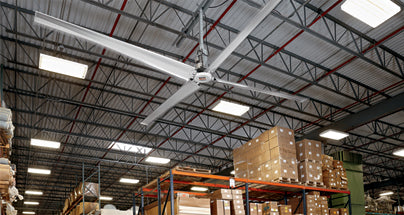Cooling down a warehouse in the Middle Eastern desert can be quite challenging due to the extreme heat. Below are several strategies one can employ to keep the workplace cool, so implement a combination of these strategies.
1. Insulation
Roof and Wall Insulation: Properly insulate the roof and walls to prevent heat from penetrating the building. Use materials with high R-values suitable for hot climates.
2. Reflective Roofing
Cool Roofs: Install reflective or white roofing materials that reflect sunlight rather than absorb it, reducing the heat entering the building.
3. VentilationNatural Ventilation: Design the warehouse with plenty of vents, louvers, and windows that can be opened to allow hot air to escape and cooler air to circulate.
Mechanical Ventilation: Use exhaust fans and industrial blowers (HVLS) to improve airflow and remove hot air from the warehouse.
4. Evaporative CoolingEvaporative Coolers: These coolers use water evaporation to lower air temperature, which can be particularly effective in dry desert climates, but this might increase the humidity.
5. DehumidificationDehumidifiers: Reduce humidity levels to make the air feel cooler and more comfortable.
6. HVAC SystemsAir Conditioning: Invest in industrial-grade air conditioning systems that are powerful enough to handle large spaces and high temperatures. Ensure regular maintenance for efficiency.
Zoning: Use zoning to cool only the high heat areas or where workers are stationed or where materials require a cool environment. This will reduce the overall load on the system.
Seal Leaks: Check and seal any gaps or cracks in doors, windows, and walls to prevent hot air infiltration.
7. Operational AdjustmentsHeat-Generating Equipment: Schedule the use of heat-generating equipment during cooler parts of the day.
Shift Work Hours: Adjust work hours to cooler times of the day to minimize heat exposure for workers.
8. ShadingExternal Shading: Install shade structures like awnings, overhangs, or shade sails around the building to reduce direct sunlight.
Landscaping: Plant trees and other vegetation around the warehouse to provide natural shade and cooling.
9. Thermal MassThermal Mass Materials: Use materials like concrete or brick that can absorb heat during the day and release it slowly at night.
10. Cool Paints and CoatingsReflective Coatings: Apply cool paints and reflective coatings on walls and roofs to reflect more sunlight and absorb less heat.
11. Automated SystemsSmart Thermostats: Use programmable thermostats to optimize cooling based on the time of day and occupancy.
Temperature Monitoring: Install sensors to monitor temperature and adjust cooling systems as needed.
12. Water FeaturesMisting Systems: Install misting systems around entrances and loading docks to lower the air temperature.
Fountains or Pools: These can help to cool the surrounding air through evaporation.
13. Energy-Efficient LightingLED Lighting: Replace traditional lighting with LED lights that generate less heat and consume less energy.
14. Radiant CoolingRadiant Cooling Panels: Install radiant cooling panels that use chilled water to absorb heat from the interior space.
